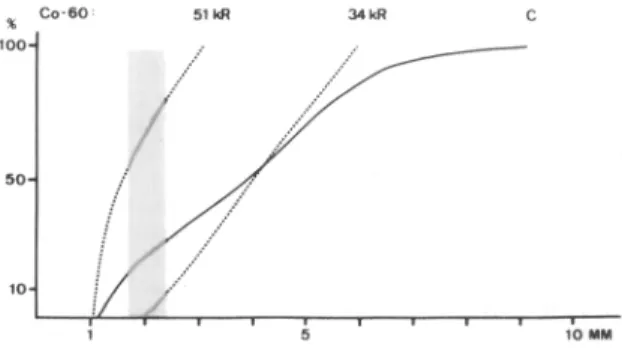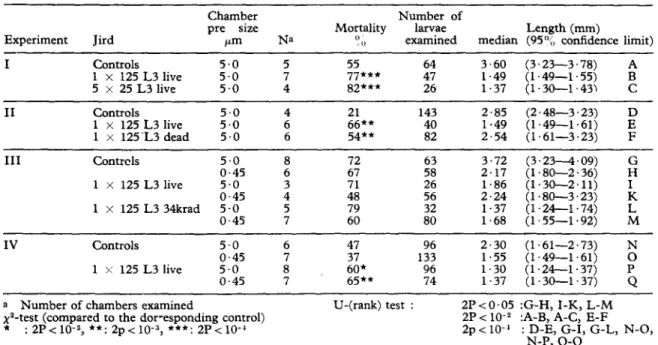173
TRANSACTIONS OF THE ROYAL SOCIETY OF TROPICAI. MEDICINE AND HYGIENE, VOL. 75, No. 1, 1981
Dipetalonema
w’teae (Filarioidea)
: development
of the infective
larvae in
micropore
chambers
implanted
into normal, infected
and immunized
jirds*
M. TANNER AND N. WEISS
Swiss Tropical Institute, CH4051 Basle, Switzerland
Using a micropore chamber technique, larval development of Dipetalonema viteae has been followed in jirds (the natural host), hamsters and mice (GASS et al., 1979). Larval development was inhibited in the mouse, an insusceptible host, when this was previously sensitized with live third-stage larvae (L3) (GASS et al., 1979). L3 no longer moulted to the fourth stage (L4). The inhibition of larval development correlated with the appearance of antibodies specific to the cuticle of L3. As in the sera of jirds infected with D. viteae, antibodies specific to the cuticle of L3 and L4 can also be detected (WEISS & TANNER, 1981); larval development was also examined in micropore chambers implanted into normal, infected and immunized jirds.
Material & Methods
The filarial parasite, D. viteae, was cyclically kept in the jird, Meirones unguiculatus, aAd the tick, Ornithodorus moubata. L3 were isolated under sterile conditions exactly as described recently (GASS et aZ., 1979). Micropore chambers with 5 -0 and 0.4 pm pore size membranes (Nucle- opore Corp.) were assembled, loaded with 30 L3 and implanted subcutaneously into jirds as already described (GASS et al., 1979). Normally a jird received one 5 -0 pm chamber or, in some experi- ments, a 5 * 0 and a 0.4 pm chamber simultaneously. Chambers were implanted into jirds two weeks after a previous infection with live L3 (1 x 125 or 5 x 25) or after the immunization wiih 1 x 125 dead (3 x freeze-thawed) or 1 a: 125 irradiated L3 (34 k;ad, 60 Co). Agelmatched uninfected jirds served as controls. Two weeks after the im- plantation, the chambers were removed, the recovered worms were measured (GASS et al., 1979) and the mortality (number of implanted L3 minus number of recovered motile worms as percentage) was assessed. All the data were recorded separately for each chamber and then pooled for evaluation as described in GASS et al. (1979). Antibodies to the cuticle of L3 and L4 were detected by the indirect immunofluorescent antibody test (IFAT) as described in WEISS & TANNER (1981).
Results & Discussion
Table I summarizes the results of four inde- pendent experiments. L3 developed to L4 inside 5 pm chambers in uninfected controls within two weeks. The median length varied between 2.3 and 3.6 mm in the four experiments. These results as well as the mortality data (with the exception of Expt. III) are consistent with earlier results on larval development within micropore chambers implanted into jirds (GASS et al., 1979).
A sipnificant larval growth inhibition was observed with& 5 ‘0 pm cgambers implanted into jirds which had been previously infected with live L3 I1 x 125 or 5 j/ 25. Exots. I-IV). The median lengths were 1.3 to’ 1.9’ mm wdich means that most larvae did not complete their moult to L4. In addition, larval mortality was, with one exception (Exut. III), significantly higher. Immunization of iirds with &radiated L3Walsoresulted in a significant larval growth inhibition (Exnt. III). In this respect Tt is noteworthy that 34-krad-irradiated L3 can complete their moult to L4 in micropore chambers (Fig. 1). Inoculated into hamsters, irradiated L3 never reached the fertile adult stage. Higher irradiation doses (51 krad) reduce the percentage of L3 moulting‘to L4 (Fig. 1). The r&ortalitv among 34 and 51 krad irradiated L3 within <micropore chambers was only slightly higher than that of the non-irradiated controls. This is consistent with similar experiments described for Dirojilaria immitis (see WONG et al., 1974), for Brugia spp. (see RAMACHANDRAN, 1970; OOTHUMAN et al., 1978, 1979) and for Litomosoides carinii (see RAO et al., 1977). The immunization of jirds with dead larvae did not provoke any larval growth inhibition (Expt. II).
Inhibited larval development correlated with the detection of antibodies specific to the cuticle of L3 and L4, i.e. the infection of jirds with live L3 and the immunization with irradiated L3 provoke the production of anticuticular antibodies. The immunization with dead L3, however, only stimu- lated antibodies against somatic antigens (cf also WEISS & TANNER, 1981).
100-
so-
Fig. 1. Cumulative frequency distribution of the length of normal (C) and irradiated larvae from 5.0 pm micropore chambers two weeks after the implantation into uninfected jirds. $he shaded area indicates the range of the third moult.
*Supported by the Swiss National Science Found- ation grant No. 3.267.78
174 DEVELOPMENT OF INFECTIVE D. viteae LARVAE IN JIRDS
Table I-Larval development in micropore chambers implanted into normal, infected and immunized jirds
Experiment Jird
Chamber Number of
pre size larvae Length (mm)
w Na
Mof;tality
,” examined median (95% confidence limit)
I Controls 1 x 125 L3 live 5 55 64 3.60 (3.23-3.78) i 77*** ii 1.49 (1.49-1.55) iii 5 x 25 L3 live 5.0 82*** 1.37 (1.30-1.43) c II Controls 5.0 2 143 2.85 (2.48-3.23) 1 x 125 L3 live 5.0 40 1.49 (1.49-1.61) 1 x 125’L3 dead 5.0 6 54** 82 2.54 (1.61-3.23) F III Contrcls 0.45 5.0 6” ;17” 48’ 3.72 2.17 (1.80-2.36) (3.234.09) H” 1 x 125 L3 live 0.45 5.0 : :A 56 26 2.24 1.86 (1.30-2.11) (1.80-3.23) x 1 x 125 L3 34krad 5.0 0.45 5 7 iz 2 1.68 1.37 (1.24-1.74) (1.55-1.92) fi IV Controls 5.0 6 47 96 2.30 (1.61-2.73) 0.45 7 37 133 1.55 (1.49-1.61) ; 1 s 125 L3 live 5.0 8 96 (1.24-1.37) I’ 0.45 7 $$* * 74 ;I;; (1.30-1.37) Q a Number of chambers examined
$--test (compared to the dor-esponding control) : 2p<10-2, **: 2p<10-“, ***: 2r<10-’
In order to get information on the mechanisms mediating larval growth inhibition, 0.4 pm cham- bers were implanted. These chambers prevent host cell immigration. Thus, the effect of anti- bodies alone can be measured. Experiments III and IV show that larval growth inside 0.4 pm chambers is significantly inhibited also within uninfected controls when compared with the corresponding 5 *O pm chambers. Nevertheless, the moult to L4 could still take place in such 0.4 pm chambers in controls (Expt. III). This was also the case within 0 * 4 pm chambers implanted into previously infected (125 live L3) or immunized (125 34 krad L3) jirds, while larval development in the corresponding 5 *O pm chambers was signifi- cantlv inhibited (Exnt. III). However, a renlicate expeiiment (IV). was inconsistent. Larval hevel- opment within 0.4 pm chambers was inhibited in controls to the same proportion as in previously infected jirds. Thus it is not yet clear if antibodies alone are responsible for the observed growth inhibition. Preliminarv studies in vitro with peritoneal exudate cells-including eosinophil en- riched cell populations-in combination with anticuticular antibodies did not promote adherence of cells to L3 and subsequent immobilization and elimination of the larvae. WONG et al. (1974) reported the appearance of antibodies specific against L3 in beagle dogs immunized with irradi- ated L3 of D. immitis. There appeared to be some evidence of correlation between L3 antibody levels and the degree of resistance of these immuni- zed dogs.
The significance of our present results in respect to protection following challenge or superinfections is currently being investigated.
U-(rank) test : 2P < 0.05 :G-H, I-K, L-M 2P < 1O-2 :A-B, A-C, E-F 2p < 10-A : D-E, G-I, G-L, N-O,
N-P, O-Q
References
Gass, R. F., Tanner, M. & Weiss, N. (1979). Development of Dipetalonema viteae third-stage larvae (Nematoda: Filaiioidea) in micropore chambers implanted into jirds, hamsters, noimal and immunized mice. Zeitschrift fur Para- sitenkunde, 61, 73-82.
Oothuman, P., Denham, D. A., McGreevy, P. B. & Nelson, G. S. (1978). Studies with Brugia pahangi. 15. Cobalt 60 irradiation of the worm. Journal of Helminthology, 52, 121-126.
Oothuman. P.. Denham. D. A.. McGreevv. P.B., Nelson,‘G. S. & Rogers, R. (1979) Success: ful vaccinatton of cats against Brugia pahaing with larvae attenuated by irradiation with 10 krad cobalt 60. Parasite Immunology, 1, 209-216.
Ramachandran, C. P. (1970). Attempts to im- munize domestic cats with X-irradiation in- fective larvae of sub-periodic Brugia malayi. 1. Parasitological aspects. Southeast Asian Journal of Tropical Medicine and Public Health, 1, 78-92. Rao, G. Y. V. B., Mehta K. & Subrahmanyam D.
(1977). Litomosoides carinii : effect of irradiation on the development and immunogenicitv of the larval forms. Experimental ParasitoTogy, ti,39-44. Weiss. N. & Tanner. M. (1981). Immunoeenicitvof
filarial larvae (i)ipet&onema viteae)c: Tr&zs- actions of the Royul Society of Tropical Medicine and Hygiene, 75.
Wong, M. M., Guest, M. F. & Lavoipierre, M. J. (1974). Dirojilaria immitis: Fate and immuno- genicity of irradiated infective stage larvae in beagles. Experimental Parasitology, 35, 465-474.

